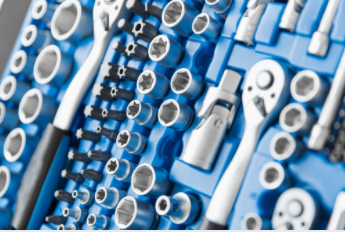A socket set is a beneficial tool for the mechanic, and for someone looking to do their repair work on cars, motorcycles and other equipment. A socket set is specifically designed to assist mechanics in loosening, removing, and adjusting any nuts or bolts in your machine or car. These socket sets come in different sizes. Regardless of your skill level and preferred method for doing repairs, every trade requires a general socket set or socket spacer for the more basic job and occasional maintenance, like changing a light bulb. Even mechanics need some form of preventative maintenance from time to time. Here are some tips for buying the right one:
 Sizes: Choose a socket set with the right size of sockets, so you end up using less of them. If you have numerous tasks that need to be performed regularly, consider getting a set with more sockets and ratchets. For example, you could get a socket set with twenty-eight sockets and ratchet pairs but only uses four of them at a time. Or, you could get a set with fewer sockets (twenty-four) and ratchets (six). The choice depends entirely upon the types of tasks you’re performing and how often you need to change the nuts and bolts.
Sizes: Choose a socket set with the right size of sockets, so you end up using less of them. If you have numerous tasks that need to be performed regularly, consider getting a set with more sockets and ratchets. For example, you could get a socket set with twenty-eight sockets and ratchet pairs but only uses four of them at a time. Or, you could get a set with fewer sockets (twenty-four) and ratchets (six). The choice depends entirely upon the types of tasks you’re performing and how often you need to change the nuts and bolts.
Ratchet Sets: Always buy a socket set with standard-sized sockets, preferably L-shaped so you can fit it onto the shaft of the bolt quickly. You want to avoid getting one which is oversized because it won’t allow you to fasten it to the bolt easily, and the added length will only serve to complicate things. Also, it won’t be as strong as the others for heavy-duty bolts and nuts. There are also many sizes of ratchet sockets which can fit through bolts with different thread counts. Some manufacturers offer different thread counts for different sizes of fasteners, such as nylon coated fasteners, so make sure you know what size you need.
Hexagon Sizes: hexagons usually come in six-point socket sets, which are the ideal size for sockets that will sit flush against each other. Six-point sockets are typically used in kitchen sockets and bathroom sinks because they aren’t as likely to snag when you clean around them. However, they’re not suitable for other purposes, such as being used on ceiling rafters or headers. Keep in mind that a six-point hexagon socket set is most expensive of all the socket sets you’ll find. So, if you don’t need to work on structures with a lot of weight, a six-sided hexagonal socket set is probably best for your needs.
Metric Sets: Many socket sets include a metric version. Because there are so many countries globally, you may find a socket set that uses a different measurement in one country than it does in another. It can cause a lot of confusion, especially if you’re purchasing a set online. However, most of the time these socket sets use the same standard, so you shouldn’t have any problems determining the size you need.
Nut And Bolts Set: Like the hexagon socket set, a nut and bolt set includes both a tapered and non-tensed head. The tapered head is the one that goes round and fits into the hole. It’s harder to tighten than the non-tensed head, but it can be tricky to loosen. Usually, the nuts and bolts are secured by springs or clips.
Extensions Set: Extenders are included with most six-point sockets, and you won’t usually need to buy additional extensions. However, some manufacturers have clip-on extensions with their socket sets. These extensions are generally for heavy-duty applications, so you should only use them if you’re using a heavy-duty set. Look carefully at the socket head before you buy an extension to make sure the clip-on fit the sockets properly.
Combination sockets Set: A combination socket set includes both a tapered and non-tensed head. You can use either fasteners or extensions, depending on your needs. The clip-on extensions can come in either hex or flat varieties, while the non-tensed versions are usually round or square. These sets can be purchased with ratchet or screw ratchets, and there are also combinations with crescent clips and pins. These sets are great for industrial applications that require more robust connections, but they’re less popular with the DIY crowd.
